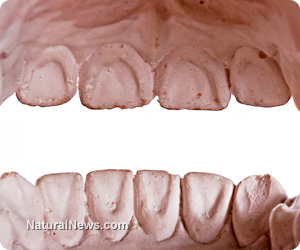
Your teeth: The latest victim of toxic BPA exposure
Thursday, June 27, 2013 by: Ethan A. Huff, staff writer
Tags: teeth, BPA, tooth enamel
- BIGGEST SCAM: You pay income tax, then taxes on purchases, then personal property tax on what you own that you already paid taxes on with taxed money
- Newly released JFK files reveal Pentagon's role in creating Lyme disease and covid in the same lab
- Analysis: The coming economic collapse, a mass uprising and Trump's three secret weapons to halt the growing revolt
- American food is the MOST TOXIC “FOOD” on earth
- EXPOSED: Antifa and IRS collude to shield radical funding from taxation
- The flu vaccine paradox: Are we making things worse?
- Big Pharma's $8 Billion bribery scheme exposed: how doctors are pushed to prescribe junk science, not heal
- A lack of integrity in Academia: Harvard professor found GUILTY of fraudulent research to promote CRT theory
- Florida takes a stand: DeSantis proposes permanent ban on mRNA vaccine mandates
- Heads up! List of food shortages expected in 2025 as the campaign of forced starvation continues to be waged against the American people
- Discovery of Texas GOP representative living in retirement home amid health challenges and congressional absence sparks uproar
- Beyond consequence
- 5 Simple steps to boost your brainpower: How to strengthen executive function in a distracted world
- Reclaim your health: How midlife exercise reverses years of inactivity
- Mike Adams Sermon 66: God will DESTROY ISRAEL for its wickedness
- Trump reverses course on Gaza plan, says “nobody is expelling Palestinians”
- Boys are back in town: Trump’s patriotic alpha crew takes the wheel while toxic females ride in the backseat
- Government seizes millions of pounds of food amid global crisis
- Reclaim your health: How midlife exercise reverses years of inactivity
- A lack of integrity in Academia: Harvard professor found GUILTY of fraudulent research to promote CRT theory
- Space war brewing? Russia threatens to destroy Starlink satellites
- EPA advisor admits the agency is funneling billions to climate groups ahead of Trump’s return to White House
- Elon Musk: Aliens could be here on Earth RIGHT NOW
- Big Pharma's $8 Billion bribery scheme exposed: how doctors are pushed to prescribe junk science, not heal
- Historian warns Israel may be entering an “IRREMEDIABLE DECLINE”
- Trump reverses course on Gaza plan, says “nobody is expelling Palestinians”
- Mike Adams Sermon 66: God will DESTROY ISRAEL for its wickedness
- Rep. Nancy Mace introduces bill to ban biological males from female facilities on federal property
- New York politicians push bill allowing governor to indefinitely detain the unvaccinated on a whim
- RFK Jr.'s SSRI antidepressant investigation sparks liberal meltdown, exposes Big Pharma's dangerous game
- 5 Simple steps to boost your brainpower: How to strengthen executive function in a distracted world
- Mark Zuckerberg's REAL NAME is Jacob Greenberg and he is the GRANDSON of DAVID ROCKEFELLER, hence the POWER of FAKEBOOK
- Survival 101: Effective EMF blocking techniques
- Sales of survival bunkers rise following Russia’s use of the Oreshnik hypersonic ballistic missile
- Trump Administration cuts 2,000 USAID jobs, places most employees on leave in sweeping reform effort
- Pilots report mysterious lights 'moving at extreme speeds' across Oregon skies
- EPA advisor admits the agency is funneling billions to climate groups ahead of Trump’s return to White House
- The Health Ranger releases “Vaccine Zombie” song and music video, using AI-animated zombies for the music video
- The pandemic as a tool for INDOCTRINATION: Understanding “The Indoctrinated Brain” by Dr. Michael Nehls
- California's social media censorship law struck down: A victory for free speech or a threat to online safety?
- Mike Adams releases new song and music video: Nothing More Disgusting Than a Globalist
- Congratulations to the FULLY UNVACCINATED as you resisted the COVID-19 PROPAGANDA MACHINE fueled by over $100 BILLION
- Mike Adams releases country western hit single: Goin’ Back in Time is Comin’ Home
- Dr. Mike Yeadon releases 15-minute testimony - WATCH - about genocidal intent of COVID “vaccines”
- RFK Jr. clears key hurdle: Sen. Susan Collins backs controversial HHS nominee, signaling a new era for health policy
- Mike Adams releases music poetry sensation: A Child of God
- Unpacking the Lies That We’ve Been Fed – new song and music video released by Mike Adams, the Health Ranger
- Trump administration takes on global censorship: A new frontier for free speech advocacy
- Ex-FBI Chief EXPOSES disgraceful government coverups of Oklahoma City Bombing, Kennedy assassinations, 9/11 WTC, and "Terrorism" as plot to destroy Constitution
- Federal judge backs Trump's mass firings, clearing path for government downsizing
- Florida takes a stand: DeSantis proposes permanent ban on mRNA vaccine mandates
- Michigan sheriff announces criminal investigation into 2020 election crimes, Dominion Voting Systems
- “Why we influenced the 2020 elections”: Facebook files reveal the coordinated effort to bury the Hunter Biden laptop story
- Bush tomato: A mighty superfood that supports digestive health
- Red Cross issues warning to stop blood plasma donations from vaccinated people
- Scientists confirm: GENIUS brain function can be spontaneously unleashed in humans without any apparent cause
- EPA advisor admits the agency is funneling billions to climate groups ahead of Trump’s return to White House
- HYSSOP: What research reveals about the health benefits of this ancient holy herb
- Two containers with completed ballots fall out of truck in Florida
- Fully vaccinated about to see “tsunami” of illness and death, warns virologist
- Today I asked our AI language model “Neo” about which phytonutrients or phytochemicals can block the spike protein related to SARS-CoV-2 … Here is what it answered…
- Global leaders unite to clamp down on “misinformation” with UN-backed Cascais Declaration
- BREAKING: 2025 NDAA authorizes mandatory military draft of WOMEN across America… as Pentagon pursues global NUCLEAR war with both Russia and China at the same time
- Michael Yon warns of a ZIONIST TAKEOVER in Trump’s second administration
- BOMBSHELL: DNA testing kits are a SCAM to develop ethnic-specific bioweapons
- Ozempic and Wegovy weight loss drugs are injectable LIZARD VENOM PEPTIDES that may unleash a devastating wave of organ failure… side effects align with symptoms of SNAKE BITES
- Israeli soldiers accused of even more torture and abuse in the West Bank
- These 13 countries just signed an agreement to engineer a global FAMINE by destroying food supply
- NASA admits that climate change occurs because of changes in Earth’s solar orbit, and NOT because of SUVs and fossil fuels
- RFK Jr. clears key hurdle: Sen. Susan Collins backs controversial HHS nominee, signaling a new era for health policy
- Sermon 30: How Jesus reveals Caesar’s FAKE CURRENCY and FALSE AUTHORITY
- Coriander seeds: Ancient medicine backed by modern science
For their study, researchers from the Institut National de la Sante et de la Recherche Medicale (INSERM) in Paris, France, investigated the effects of BPA on rats at intervals ranging from birth to either 30 or 100 days. They kept a close eye on the oral health of the rats during this time, looking for any noteworthy changes that occurred in contrast to rats not exposed to the toxic industrial chemical.
At day 30, the team reportedly observed that the BPA-exposed rats had developed clear signs of MIH, which included the abnormal accumulation of albumin and other organic materials. This buildup led to fragile and brittle enamel formation, which in turn made the rats more prone to tooth decay and cavities. Two key genes involved in healthy tooth and enamel formation, enamelin and kallicrein 4, were found to have been obstructed as a result of BPA exposure.
"Insofar as BPA has the same mechanism of action in rats as in men, it could also be a causal agent of MIH," says Sylvie Babajko, author of the new study. "Therefore, teeth could be used as early markers of exposure to endocrine disruptors acting in the same way as BPA and so could help in early detection of serious pathologies that would otherwise have occurred several years later."
Specifically, BPA appears to disrupt the formation of enamel on teeth during the developmental years, a process that is necessary for healthy teeth later in life. And because it is an endocrine disruptor, which means it negatively affects hormonal balance, BPA could just be the tip of the iceberg as far as damage to teeth is concerned. The presence of MIH on teeth, in other words, could be caused not only by BPA, but also by a host of other endocrine disrupting compounds (EDCs).
"Because human enamel defects are irreversible, MIH may provide an easily accessible marker for reporting early EDC exposure in humans," say the authors.
You can view the study's abstract for free here:
http://www.journals.elsevierhealth.com
Reduce your BPA exposure by not touching thermal receipts, avoiding cans and plastic bottles
This is all highly concerning, as the primary substitute for amalgam (mercury alloy) fillings in teeth is composite resin fillings that more often than not contain BPA. In fact, composite fillings that contain BPA derivatives like Bis-GMA have actually been shown to be more harmful than many other common sources of BPA, which include things like polycarbonate plastic bottles and containers, plastic wrap, thermal paper receipts, food can linings, and even paper money.The overall findings of the AJP study, however, affirm the notion that BPA harms developing mammals in a number of important ways. General BPA exposure has been linked in a cohort of studies to causing brain damage, reproductive problems, behavioral abnormalities, and even cancer.
"BPA is found in many drinking containers, the lining of most food and beverage cans (including soda cans), bottle caps, plastic cutlery, plastic food storage containers, toys, dental sealants, some dental composites, water pipes, eyeglass lenses, and more," explains Mother Earth News. "Polycarbonate is often blended with other plastics to create products such as mobile phone cases, car parts, electronic equipment, medical equipment and household items. Because BPA is in printer ink, newspapers and carbonless receipts, most recycled paper contains it, including paper towels and paper used to contain food."
Sources for this article include:
http://presse-inserm.fr
http://www.sciencedaily.com/releases/2013/06/130610133246.htm
http://chemicalwatch.com
http://www.motherjones.com
http://www.motherearthnews.com
Teeth at FETCH.news
Get independent news alerts on natural cures, food lab tests, cannabis medicine, science, robotics, drones, privacy and more.
Take Action: Support Natural News by linking to this article from your website
Permalink to this article:
Embed article link: (copy HTML code below):
Reprinting this article:
Non-commercial use OK, cite NaturalNews.com with clickable link.
Follow Natural News on Facebook, Twitter, Google Plus, and Pinterest
Science News & Studies
Medicine News and Information
Food News & Studies
Health News & Studies
Herbs News & Information
Pollution News & Studies
Cancer News & Studies
Climate News & Studies
Survival News & Information
Gear News & Information
News covering technology, stocks, hackers, and more



"Big Tech and mainstream media are constantly trying to silence the independent voices that dare to bring you the truth about toxic food ingredients, dangerous medications and the failed, fraudulent science of the profit-driven medical establishment.
Email is one of the best ways to make sure you stay informed, without the censorship of the tech giants (Google, Apple, Facebook, Twitter, YouTube, etc.). Stay informed and you'll even likely learn information that may help save your own life."
–The Health Ranger, Mike Adams













































